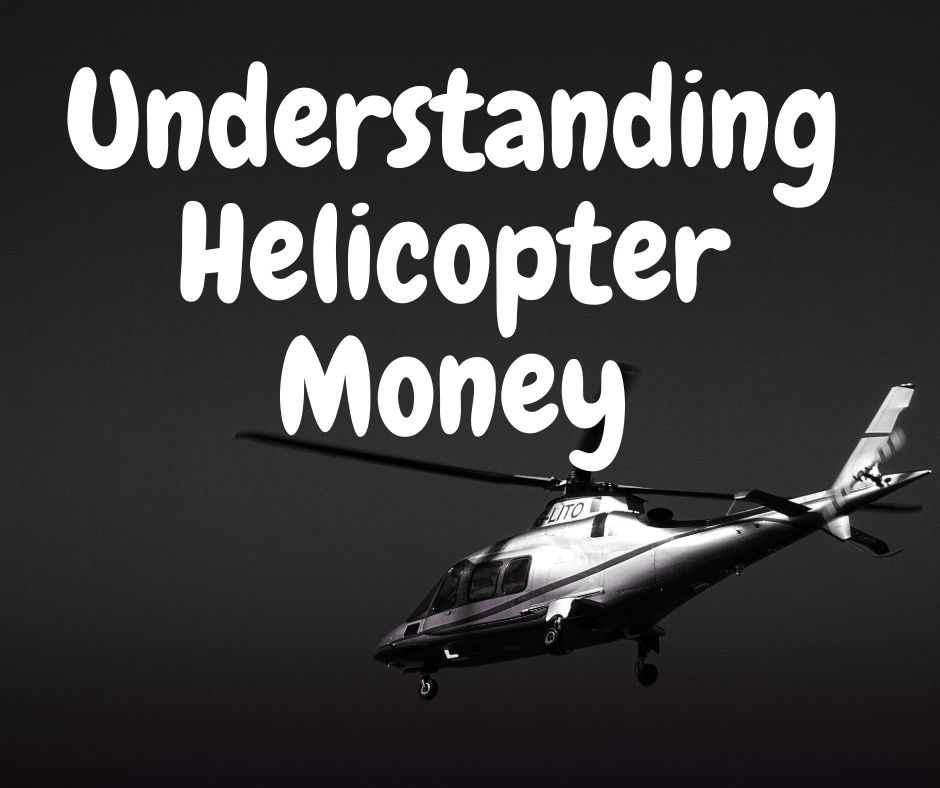Helicopter Money: Meaning | Origin | Effect on Economy
- 14 April 2020 | 1167 Views | By Abhinav Mishra

Helicopter money is the term utilized for an enormous amount of new money that is printed and disseminated among people in general. This is to increase the economy during a downturn or when financing costs are decreasing to zero.
Helicopter Money or Helicopter Drop is an expansionary financial approach that is financed by the supply of money in the economy. It could be an expansion in spending or a tax reduction, yet it includes printing a huge set of money and circulating it to the general population so as to invigorate the economy. For the most part, the term ‘helicopter money’ is to a great extent a great step for unusual measures to kick off the economy during deflationary periods.

While ‘helicopter drop’ was first referenced by a great market analyst Milton Friedman, it picked up prominence after Ben Bernanke made a passing reference to it. He got a nickname as a ‘Helicopter Ben’ that stayed with him till his tenure.
Helicopter money is an unconventional option in contrast to quantitative easing, however, both expect to support purchaser spending and increment in inflation. While helicopter cash increments money related stockpile by conveying a lot of cash to general society, quantitative easing expands supply by buying government or other monetary protections to start financial development.
Origin of Helicopter Money
Milton Friedman thought of the idea of helicopter money or sometimes called a helicopter drop in 1969. The Nobel Prize-winning financial specialist conceived a whirlybird flying over a network dropping paper money from the sky as a psychological test to perceive what a never-to-be-repeated increment in the cash supply would do to spending and saving money. The thought was put on the map by Ben Bernanke in 2002 when, as a Federal Reserve senator, he alluded to it while contending that a national bank can generally stir expansion if necessary.
The nickname “Helicopter Ben” stuck, despite the fact that the playbook Bernanke followed as Fed administrator during the recession that followed the budgetary emergency avoided printing cash and giving it out to shoppers. In an April 2016 blog entry, in any case, Bernanke said helicopter cash might be “the best accessible other option” under some “extraordinary conditions.” In the present discussions, it’s conceived that helicopter money would be disseminated either by crediting individuals’ bank adjustments or as an assessment discount. The key is that it would originate from a one-time production of cash by the national bank, instead of being acquired by the administration or coming out of existing spending.
Pros of Helicopter Money
Helicopter cash doesn’t depend on consumers who will increase demand and fuel the economy, which implies that it doesn’t make more debt and loan fees (interest rates) can stay unaltered. For the most part, helicopter money helps spending and monetary development be more viable than quantitative easing in light of the fact that it builds total interest – the interest for products and ventures – right away.
While government money drops that originate from debt probably won’t help in more spending from consumers but it is believed that ‘money finance’ will boost the economy.
More cash in supply ought to send individuals into shops, something that the market analysts accept could help support trust in the economy, and eventually, costs of products begin to rise. A spike in costs for products and ventures is constantly observed as something to be thankful for, as deflation regularly prompts broadened times of stagnation.
Supporters of Helicopter money have consistently contended that pumping more cash into buyers’ hands is a certain method for boosting expansion levels contrasted with quantitative easing that seems to have fuelled an air pocket in the stock market. The way that helicopter money prompts benefits being spread far and wide and not very barely any individuals has likewise observed it keep gathering support as a valuable method for countering deflation.
What is the problem with Helicopter Money?
In contrast to quantitative easing, many have supported that utilizing helicopter cash is not a good solution. The economy will hit because of this.
A nation’s national bank sets its loan costs (interest rates) to reach the financial development targets. However, a helicopter drop implies that a national bank can’t utilize financing costs to recoup any expenses, on the grounds that the cash isn’t connected to an acquired loan (credit). Rather, the money is offered legitimately to the general population. This may prompt over-expansion and cause harm to the national bank’s financials.
One of the primary consequences related to helicopter money is that it could lower our currency value. And because of this, it can also hit the foreign exchange trade. As more cash is printed and supply expands, the estimation of the domestic money could essentially diminish. It could likewise debilitate speculators who invest money from purchasing the cash as it is less inclined to perform well.
First off printing more money just goes on to debase the purchasing influence of whatever amount of cash individuals have left in their savings. More cash available for use additionally depreciates the basic money in a similar way the issuance of more shares of an organization weakens possessions of the current investors.
Printing and getting more money available for use, just like the case with Helicopter money, may likewise trigger expanded degrees of inflation beyond the prescribed 2% level. Zimbabwe is one of the nations that is battling with one of the most elevated expansion levels following the printing of more cash.
Helicopter Money on its Way
The following phase of unconventional fiscal strategy – if the dangers of the downturn, deflation and money related emergency forcefully increment – could have three segments. To begin with, national banks could charge money to keep banks from endeavoring to dodge the negative-rate charge on excess saves. With banks incapable to switch into money (along these lines acquiring zero rates), national banks could go significantly increasingly negative with their policy rates.
Second, QE could develop into a “helicopter drop” of cash or direct money related financing by national banks of bigger monetary shortfalls. In fact, the ongoing business sector buzz has been about the advantages of lasting adaptation of open shortfalls and obligation. Additionally, while QE has profited holders of monetary resources by boosting the costs of stocks, bonds, and land, it has likewise energized rising disparity. A helicopter drop (through tax reductions or moves financed by recently printed cash) would put cash legitimately under the control of family units, boosting utilization.
Helicopter cash adequacy doesn’t require the national bank to soundly submit never to pull back the related increment for possible later use. There is no natural method of reasoning for overabundance holds given under helicopter cash to pay a premium. Along these lines, the financial expense of helicopter money is nil.
Fiat cash would then be able to be utilized at no expense to the public sector asset report as an approach to activate jobless genuine assets and to quicken costs and wages in economies hit by huge, industrious yield holes and low inflation.
Conclusion
While Helicopter cash seems, by all accounts, to be hypothetically possible, it is as yet a theoretical money related approach tool. Its execution in profoundly developed and created economies is exceptionally implausible, given the potential consequences that may become possibly the most important factor.
Lowering the currency value, just as very high expansion levels, are a portion of the repercussions that policymakers would not be prepared to fight with ought to infuse more cash into the economy to have the ideal effect. With helicopter money, the estimation of money could endure a huge shot in the foreign market, a move that would make imports amazingly costly, introducing one more issue to a battling economy.









